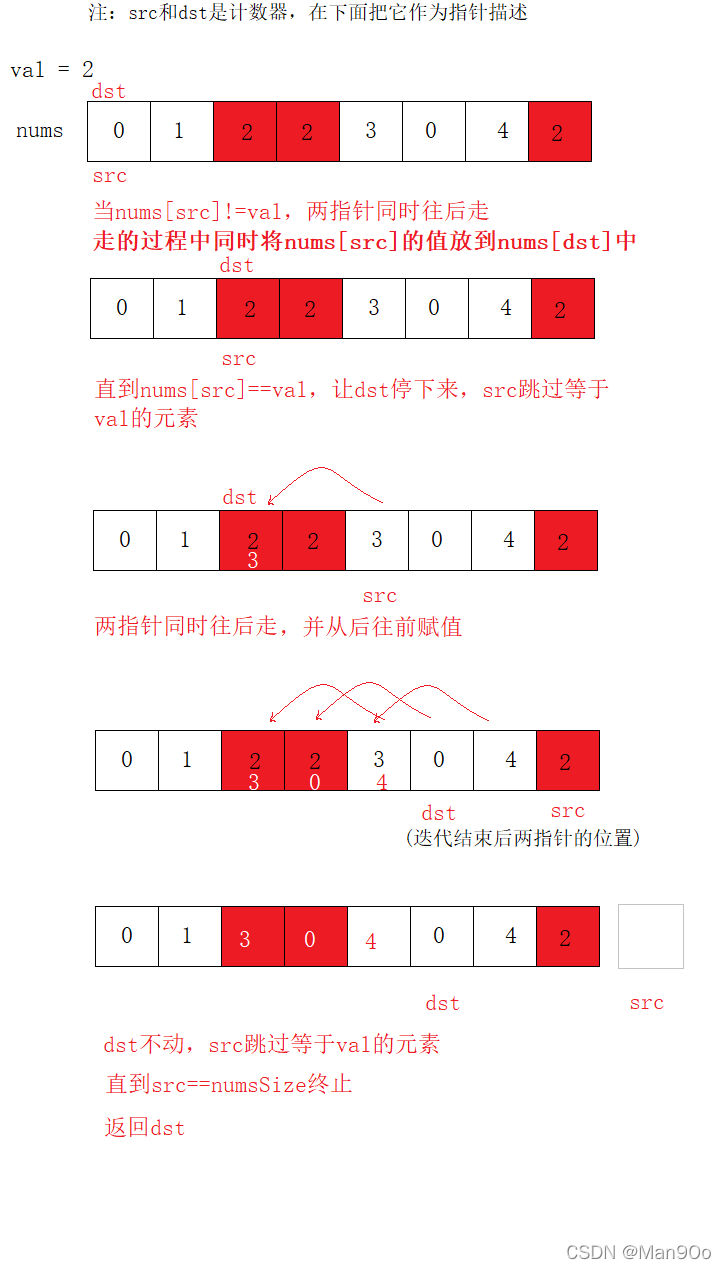顺序表 链表刷题【C语言实现】
1. 顺序表
说明:由于nums[src]等价于*(nums + src),故以下将将下标计数器简化称作指针
1.1 移除元素

思路:

题目要求的空间复杂度O(1)的言外之意是不另外开辟数组空间,直接在原数组上进行删除元素的操作。一般情况下:如果只删除数组中的其中一个元素,只需将它后面的所有元素向前移动一位,将它覆盖即删除。而这道题有多个要删除的元素,核心思想也是一样的
“将它后面的所有元素向前移动一位”的前提条件是后面所有元素都不等于val(要删除的数)

那么有多个val的情况也是类似地,以val为分界线

如何达到分割数组的效果?
dst和src指针同时出发,当遇到val,dst停下,让src继续走直到不遇到val为止,然后再同时走,直到src(src走的快)遍历完数组。这相当于将等于val的元素跳过,分割数组的目的就是删除等于val的元素。注意:dst和src在同时走时,要将src的值赋给dst
- 循环终止条件:src遍历完数组
- 返回值:dst
int removeElement(int* nums, int numsSize, int val){
int dst = 0;
int src = 0;
while(src < numsSize)
{
if(nums[src] == val)
{
src++;
}
else
{
nums[dst] = nums[src];
dst++;
src++;
}
}
return dst;
}
1.2 删除有序数组中的重复项

思路:

int removeDuplicates(int* nums, int numsSize){
int dst = 0;
int src = 0;
while(src < numsSize)
{
if(nums[dst] == nums[src])
{
src++;
}
else
{
nums[++dst] = nums[src++];//注意这里是将src位置的值赋值给dst的下一个位置
}
}
return dst + 1;
}
找到每个分界点,且将它们组成的区间内的元素删除,思路和上一题类似:dst记录覆盖后的位置,src找下一个分界点。当src找到分界点,将其值赋值给dst的下一个位置(因为dst当前的位置是相对于src的上一个分界点),然后src继续找,直到遍历完数组。
- 循环终止条件:src遍历完数组
- 返回修改后的数组长度:dst+1(dst是下标,从0开始)
1.3 合并两个有序数组

思路:

这是归并排序的核心思想,前提是要比较的两个数组已经排好顺序
- 循环终止条件:至少有一个数组遍历完毕。实际上,这里num1一定会遍历完的,因为num1剩余的空间要存放num2
void merge(int* nums1, int nums1Size, int m, int* nums2, int nums2Size, int n){
//都是下标
int end = nums1Size - 1;
int end1 = m - 1;
int end2 = n - 1;
while(end1 >= 0 && end2 >= 0)//把小的放进去
{
if(nums1[end1] > nums2[end2])
{
nums1[end] = nums1[end1];
end--;
end1--;
}
else
{
nums1[end] = nums2[end2];
end--;
end2--;
}
}
while(end2 >= 0)//num2可能有剩余元素
{
nums1[end] = nums2[end2];
end--;
end2--;
}
return nums1;
}
1.4 轮转数组

思路:

这种轮转(左旋/右旋)的题,不论是轮转字符串、数组,都可以用这种思想:各部分逆置+整体逆置。
- 重点是用k找到分界线
- 逆置功能写成单独的函数
- 当k大于数组长度,将k模上长度即可
//逆置函数
void reverse(int* nums, int start, int end)
{
int left = start;
int right = end - 1;
while(left < right)
{
int tmp = nums[left];
nums[left] = nums[right];
nums[right] = tmp;
left++;
right--;
}
}
void rotate(int* nums, int numsSize, int k){
k %= numsSize;
if(k < numsSize)
{
reverse(nums, 0, numsSize - k);//前一部分
reverse(nums, numsSize - k, numsSize);//后一部分
reverse(nums, 0, numsSize);//整体
}
}
1.5 数组形式的整数加法

2. 链表
2.1 移除链表元素

思路:

因为单向链表的局限性,只能用三个指针维护要删除节点的前中后三个节点
- 三指针同时迭代的条件:cur->val != val
- 让prev指向next之前,要先用cur得到next。并且要先free掉cur当前的值再更新cur的位置
- 删除的节点若为第一个节点,则需要更新head的地址
struct ListNode* removeElements(struct ListNode* head, int val){
struct ListNode* cur = head;
struct ListNode* prev = NULL;
while(cur)
{
if(cur->val == val)
{
struct ListNode* next = cur->next;
//如果要删除的是第一个节点
if(prev == NULL)//cur指向head,prve为空
{
free(cur);
head = next;//更新第一个节点
cur = head;//迭代cur
}
else
{
prev->next = next;//迭代prev
free(cur);
cur = next;//迭代cur
}
}
else
{
prev = cur;
cur = cur->next;//迭代
}
}
return head;
}
注:其实next指针不用每次都更新它,因为只有在碰到要删除的节点要需要用到它,所以这里将最后一个else语句中的next迭代放到了第二个if语句中
2.2 反转链表

思路:遍历,反向

此思路比较简单,同样是三指针同时迭代,为了可读性,这里将要返回的指针命名为newhead
struct ListNode* reverseList(struct ListNode* head){
struct ListNode* cur = head;
struct ListNode* newhead = NULL;
while(cur)
{
struct ListNode* next = cur->next;//保存cur的下一个节点
cur->next = newhead;//cur逆指
newhead = cur//更新
cur = next;//更新
}
return newhead;
}
2.3 链表的中间结点

思路:

快慢指针是一个经典方法,十分巧妙。接下来会介绍快慢指针的更多用法。
- 奇数个节点循环终止的条件是迭代到最后一个节点,偶数个节点循环终止的条件是迭代到NULL(即最后一个节点的next)。所以循环终止的条件有两个。
struct ListNode* middleNode(struct ListNode* head){
struct ListNode* fast = head;
struct ListNode* slow = head;
while(fast && fast->next)
{
slow = slow->next;
fast = fast->next->next;
}
return slow;
}
为什么循环条件是&&而不是||?
2.4 链表中倒数第k个结点

思路:

让快指针先走k步,作用是锁定了两指针之间的距离
- 注意判断链表是否为空和k是否大于链表长度
struct ListNode* FindKthToTail(struct ListNode* pListHead, int k ) {
int len = 0;
struct ListNode* fast = pListHead;
struct ListNode* slow = pListHead;
struct ListNode* cur = pListHead;
while(cur)//计算链表的长度
{
len++;
cur = cur->next;
}
if(len == 0 || k > len)
{
return NULL;
}
while(k--)//让fast先走k步
{
fast = fast->next;
}
while(fast)//让快慢指针同时走
{
fast = fast->next;
slow = slow->next;
}
return slow;
}
2.5 合并两个有序链表

思路:

这是归并排序的核心思想
- 新链表的每次更新,都要更新cur
- 注意链表为空的情况。一共有三种情况:只有list1为空;只有list2为空;全为空。如何处理?
- 若原链表长度不同,最后一定会有剩下的节点,只需将它们链接到新链表的当前位置即可。同样需要判断是哪一个链表还剩。
struct ListNode* mergeTwoLists(struct ListNode* list1, struct ListNode* list2){
struct ListNode* l1 = list1;
struct ListNode* l2 = list2;
struct ListNode* listhead = NULL;
//判断链表为空
if(l1 == NULL)
{
return l2;
}
if(l2 == NULL)
{
return l1;
}
//把第一个val小的节点作为listhead
struct ListNode* cur = NULL;//迭代指针变量
if(l1->val < l2->val)
{
listhead = cur = l1;
l1 = l1->next;
}
else
{
listhead = cur = l2;
l2 = l2->next;
}
while(l1 && l2)
{
if(l1->val < l2->val)
{
cur->next = l1;
l1 = l1->next;
}
else
{
cur->next = l2;
l2 = l2->next;
}
cur = cur->next;
}
//此时至少有一个走完,将剩下的连接上
if(l1 == NULL)
{
cur->next = l2;
}
else
{
cur->next = l1;
}
return listhead;
}
2.6 链表分割
注:头节点(哨兵位节点)和第一个节点不同,头节点仅存放了第一个节点的地址,不存放数据,第一个节点才是真正有数据的节点。可以理解为头节点就是一个代号,代表着这个链表

思路:

其核心思路为:先分组,再链接。
- 链接时注意不要链接到要free掉的节点
- free掉开辟的内存
ListNode* partition(ListNode* pHead, int x) {
struct ListNode* cur = pHead;
struct ListNode* greaterHead, *greaterTail, *lesstail, *lesshead;
//为两个头节点开辟内存
greaterHead = greaterTail = (struct ListNode*)malloc(sizeof(struct ListNode));
lesstail = lesshead = (struct ListNode*)malloc(sizeof(struct ListNode));
lesstail->next = NULL;
greaterTail->next = NULL;
//分组
while (cur)
{
if(cur->val < x)
{
lesstail->next = cur;
lesstail = lesstail->next;
}
else
{
greaterTail->next = cur;
greaterTail = greaterTail->next;
}
cur = cur->next;//注意迭代!
}
lesstail->next = greaterHead->next;//跳过头节点再链接
greaterTail->next = NULL;
pHead = lesshead->next;//更新pHead
free(lesshead);
free(greaterHead);
return pHead;
}
2.7 链表的回文结构

思路:

为什么会出现最后那个巧合?
因为将后半部分逆置时并没有处理中间节点前面的节点(这里是2),也就是说,倒置完以后,2依然是指向3的。这个巧妙的巧合就免去了当链表节点个数为奇数时,还要增加一系列条件判断,例如节点为个数奇数时,cur2后半部分的最后一个节点不需要比较等(因为对称轴没法跟谁比)。
class PalindromeList {
public:
bool chkPalindrome(ListNode* A) {
ListNode* fast = A;
ListNode* slow = A;
ListNode* cur1 = A;
ListNode* cur2 = NULL;
while(fast->next && fast)//找中
{
fast = fast->next->next;
slow = slow->next;
}
//此时slow指向中间节点
while(slow)//逆置后一半
{
ListNode* next = slow->next;
slow->next = cur2;
cur2 = slow;
slow = next;
}
//此时cur2是后半部分的第一个节点
while(cur1 && cur2)
{
if(cur1->val != cur2->val)
{
return false;
}
else//迭代
{
cur1 = cur1->next;
cur2 = cur2->next;
}
}
//当前面
return true;
}
};
2.8 相交链表

思路:

struct ListNode *getIntersectionNode(struct ListNode *headA, struct ListNode *headB) {
struct ListNode * cur1 = headA;
struct ListNode * cur2 = headB;
struct ListNode * cur11 = headA;
struct ListNode * cur22 = headB;
if(headA == NULL || headB == NULL)
{
return NULL;
}
int len1 = 0, len2 = 0;
//计算链表的长度
while(cur1)
{
len1++;
cur1 = cur1->next;
}
while(cur2)
{
len2++;
cur2 = cur2->next;
}
int k = abs(len1 - len2);//得出链表长度之差的绝对值
if(len1 > len2)
{
while(k--)
{
cur11 = cur11->next;
}
}
else
{
while(k--)
{
cur22 = cur22->next;
}
}
//此时两链表处于同一起始点(距离交点的长度)
while(cur11 && cur22)
{
if(cur11 != cur22)
{
cur11 = cur11->next;
cur22 = cur22->next;
}
else
{
return cur22;
}
}
return NULL;
}
更新日志
4/15/2022
man9o




